Compressed Air Energy Storage System with Burner and Ejector
Abstract
1. Introduction
2. Architecture of Energy Storage System
2.1. Compressed-Air Energy Storage System with Ejector and Combustor
2.2. Mathematic Model
2.2.1. Expander
2.2.2. Heat Exchanger
2.2.3. Gas Storage Tank
2.2.4. Regulating Valve
3. Energy Storage Condition
4. Multi-Timescale Energy-Release Condition
4.1. Short-Timescale Condition
4.1.1. Energy-Release Stage
4.1.2. Timescale Determination
- (1)
- The compressed air is an ideal gas;
- (2)
- The gas loss at the pipes and valves are ignored;
- (3)
- The temperature change in the process of compression and depressurization of gas storage device is not considered. (The energy storage system has a heat-exchange device, so the internal temperature change of gas storage device is ignored and regarded as an isothermal expansion process.)
4.1.3. Simulation Analysis
4.2. Long-Timescale Condition
4.2.1. Energy-Release Stage
4.2.2. Ejector Model
4.2.3. Combustor Model
4.2.4. Timescale Determination
4.2.5. Simulation Analysis
4.3. Continuous-Output Condition
4.3.1. Constraint Conditions
4.3.2. Simulation Analysis
5. Conclusions
- (1)
- The new system can meet the needs of multiple timescales under different operating conditions. The energy-storage stage of the new system is consistent with that of the AA-CAES system, and there are three operation modes in the energy-release stage which can flexibly adapt to three power-generation conditions: short timescale, long timescale, and continuous output.
- (2)
- Under the short-timescale condition, the ejector and combustor are not put into operation, and the CAES system operates as adiabatic compression/expansion processes, which do not need to burn natural gas and are environmentally friendly.
- (3)
- Under medium- and long-timescale conditions, the ejector and combustor are put into operation to prolong the duration of the power generation, so that the new system can meet the needs of long-timescale power generation. Moreover, the power-generation duration and capacity of the system improve with the increase of the ejector coefficient and burner thermal power. When the ejector coefficient is 0.8 and the burner thermal power is 10 MW, the power-generation time is 12.45 h, and the power-generation capacity is 140,052 kW∙h, which are 15.6 and 17.5 times that of the short-timescale conditions, respectively.
- (4)
- Under the continuous-output condition, the energy-storage system and energy-release system operate at the same time. The energy-storage subsystem provides high-pressure compressed air for the energy-release stage, while the generator provides electricity for the energy-storage subsystem. By selecting equipment parameters according to the constraint conditions, the new system can realize continuous power output.
Author Contributions
Funding
Data Availability Statement
Conflicts of Interest
Nomenclature
| AA-CAES | Advanced adiabatic compressed-air energy storage |
| CAES | Compressed-air energy storage |
| Valve admittance | |
| Characteristic function of regulating valve | |
| , | |
| Air adiabatic index | |
| Power consumption of compressor motor | |
| Generating power of expanders under short-timescale condition | |
| Intake temperature of stage expander | |
| Air temperature inside pipe-wall | |
| Average temperature of pipe-wall | |
| Average temperature of heat-transfer medium | |
| Wall temperature of gas storage tank | |
| Air temperature in gas storage tank | |
| End time of energy storage stage | |
| Air temperature at the initial time | |
| Air temperature at the end time | |
| Working time of energy storage process | |
| Working time of energy-release process under short-timescale condition | |
| Working time of energy-release process under long-timescale condition | |
| Fluid compressibility | |
| Motor efficiency | |
| Compressor efficiency | |
| Generator efficiency | |
| Expander efficiency | |
| Suction coefficient of ejector | |
| Conversion efficiency of combustor |
References
- Zhang, J.; Daniel, A.; Fang, Y.; Desmond, A.; Antwi, E.O. Review on China’s renewable energy and future projections. Int. J. Smart Grid Clean Energy 2018, 7, 218–224. [Google Scholar] [CrossRef]
- Arabkoohsar, A.; Machado, L.; Koury, R.N.N. Operation analysis of a photovoltaic plant integrated with a compressed air energy storage system and a city gate station. Energy 2016, 98, 78–91. [Google Scholar] [CrossRef]
- Denholm, P.; Sioshansi, R. The value of compressed air energy storage with wind in transmission-constrained electric power systems. Energy Pol. 2009, 37, 3149–3158. [Google Scholar] [CrossRef]
- Singh, S.; Singh, M.; Kaushik, S.C. Feasibility study of an islanded microgrid in rural area consisting of PV, wind, biomass and battery energy storage system. Energy Convers. Manag. 2016, 128, 178–190. [Google Scholar] [CrossRef]
- Razmi, A.R.; Soltani, M.; Ardehali, A.; Gharali, K.; Dusseault, M.; Nathwani, J. Design, thermodynamic, and wind assessments of a compressed air energy storage (CAES) integrated with two adjacent wind farms: A case study at Abhar and Kahak sites, Iran. Energy 2021, 221, 119902. [Google Scholar] [CrossRef]
- Zhang, X.J.; Chen, H.S.; Liu, J.C.; Li, W.; Tan, C.Q. Research progress in compressed air energy storage system: A review. Energy Storage Sci. Technol. 2012, 1, 26–40. [Google Scholar]
- Gallo, A.B.; Simões-Moreira, J.R.; Costa, H.K.M.; Santos, M.M.; Moutinho dos Santos, E. Energy storage in the energy transition context: A technology review. Renew. Sustain. Energy Rev. 2016, 65, 800–822. [Google Scholar] [CrossRef]
- Koohi-Fayegh, S.; Rosen, M.A. A review of energy storage types, applications and recent developments. J. Energy Storage 2020, 27, 101047. [Google Scholar] [CrossRef]
- Chen, L.; Zheng, T.; Mei, S.; Xue, X.; Liu, B.; Lu, Q. Review and prospect of compressed air energy storage system. Clean Energy 2016, 4, 529–541. [Google Scholar] [CrossRef]
- Olabi, A.; Wilberforce, T.; Ramadan, M.; Abdelkareem, M.A.; Alami, A.H. Compressed air energy storage systems: Components and operating parameters—A review. J. Energy Storage 2021, 34, 102000. [Google Scholar] [CrossRef]
- Wen, X.K.; Zhang, S.H.; Deng, T.T.; Li, P.; Chen, W. A Summary of Large Capacity Power Energy Storage Peak Regulation and Frequency Adjustment Performance. Power Gener. Technol. 2018, 39, 487–492. [Google Scholar]
- Ibrahim, H.; Ilinca, A.; Perron, J. Energy storage systems—Characteristics and comparisons. Renew. Sustain. Energy Rev. 2008, 12, 1221–1250. [Google Scholar] [CrossRef]
- Venkataramani, G.; Parankusam, P.; Ramalingam, V.; Wang, J. A review on compressed air energy storage—A pathway for smart grid and polygeneration. Renew. Sustain. Energy Rev 2016, 62, 895–907. [Google Scholar] [CrossRef]
- Han, Z.H.; An, P.; Guo, S.C.; Jiang, K.Z. Thermodynamics Performances Analysis of Advanced Adiabatic Compressed Air Energy Storage System Based on Solar Auxiliary Heating. Acta Energ. Sol. Sin. 2020, 41, 243–250. [Google Scholar]
- Tong, Z.; Cheng, Z.; Tong, S. A review on the development of compressed air energy storage in China: Technical and economic challenges to commercialization. Renew. Sustain. Energy Rev. 2021, 135, 110–178. [Google Scholar] [CrossRef]
- Budt, M.; Wolf, D.; Span, R.; Yan, J. A review on compressed air energy storage: Basic principles, past milestones and recent developments. Appl. Energy 2016, 170, 250–268. [Google Scholar] [CrossRef]
- Raju, M.; Khaitan, S.K. Modeling and simulation of compressed air storage in caverns: A case study of the Huntorf plant. Appl. Energy 2012, 89, 474–481. [Google Scholar] [CrossRef]
- Liu, J.L.; Wang, J.H. A comparative research of two adiabatic compressed air energy storage systems. Energy Convers. Manag. 2016, 108, 566–578. [Google Scholar] [CrossRef]
- Guo, H.; Xu, Y.; Zhang, X.; Guo, C.; Chen, H. Off-design Performance of Compressed Air Energy Storage System with Thermal Storage, Proceedings of the CSEE 2019, Fredericton, Canadian, 18–21 August 2019; Elsevier: Amsterdam, The Netherlands, 2019; Volume 39, pp. 1366–1377. [Google Scholar]
- Du, P.; Cui, H.J. Compressed air energy storage commercial power station connected to the grid in Feicheng, Shandong Province. State Grid News 2021, 08–09, 3. [Google Scholar]
- Li, G.K.; Wang, G.H.; Xue, X.D.; Chen, L.J.; Mei, S.W. Design and Analysis of Condenser Mode for Jintan Salt Cavern Compressed Air Energy Storage Plant of China. Autom. Electr. Power Syst. 2021, 45, 91–99. [Google Scholar]
- Zhang, X.J. Investigation on Compressed Air Energy Storage System. Ph.D. Thesis, Institute of Engineering Thermophysics of Chinese Academy of Sciences, Beijing, China, 2011. [Google Scholar]
- Han, Z.H.; Guo, S.C. Analysis of Operation Characteristic on Discharge Process of AA-CAES System. Acta Energ. Sol. Sin. 2020, 41, 295–301. [Google Scholar]
- Kamyar, R.; Ehsan, S.; Roydon, A.F. A comprehensive data-driven study of electrical power grid and its implications for the design, performance, and operational requirements of adiabatic compressed air energy storage systems. Appl. Energy 2020, 257, 113990. [Google Scholar]
- Wen, X.K.; Wu, P.; Zhang, S.H.; Wu, M. Study on Primary Frequency Modulation Parameter Setting of Compressed Air Energy Storage. In Proceedings of the 2nd International Conference on Green Energy and Applications, Singapore, 24–26 March 2018; pp. 143–146. [Google Scholar]
- Yang, C.; Li, P.; Sun, L.; Chai, J. Improved Strategy for Load Shedding Anti-overspeed of Compressed Air Energy Storage Expansion Generators. Acta Energ. Sol. Sin. 2021, 42, 449–454. [Google Scholar]
- Razmi, A.; Janbaz, M. Exergoeconomic assessment with reliability consideration of a green cogeneration system based on compressed air energy storage (CAES). Energy Convers. Manag. 2020, 204, 112320. [Google Scholar] [CrossRef]
- Li, Y.W.; Miao, S.H.; Yin, B.X.; Zhang, S.X.; Zhang, S.Y. Optimal Dispatch Model for Micro Integrated Energy System Considering Multi-carrier Energy Generation Characteristic of Advanced Adiabatic Compressed Air Energy Storage. Power Gener. Technol. 2020, 41, 40–49. [Google Scholar] [CrossRef]
- Bafrani, H.A.; Sedighizadeh, M.; Dowlatshahi, M.; Ershadi, M.H.; Rezaei, M.M. Spinning reserve stochastic model of compressed air energy storage in day-ahead joint energy and reserve market using information gap decision theory method. Int. J. Electr. Power Energy Syst. 2022, 141, 108123. [Google Scholar] [CrossRef]
- Deng, M. Research on Operation Control of Wind-Storage Combined System Based on Compressed Air Energy Storage. Master’s Thesis, North China Electric Power University, Baoding, China, 2019. [Google Scholar]
- Razmi, A.; Soltani, M.; Aghanajafi, C.; Torabi, M. Thermodynamic and economic investigation of a novel integration of the absorption-recompression refrigeration system with compressed air energy storage (CAES). Energy Convers. Manag. 2019, 187, 262–273. [Google Scholar] [CrossRef]
- Alirahmi, S.M.; Razmi, A.R.; Arabkoohsar, A. Comprehensive assessment and multi-objective optimization of a green concept based on a combination of hydrogen and compressed air energy storage (CAES) systems. Renew. Sustain. Energy Rev. 2021, 142, 110850. [Google Scholar] [CrossRef]
- Li, G.K.; Chen, L.J.; Xie, Y.G.; Gao, B.; Zheng, T.W.; Mei, S.W. Coordinated Optimization Strategies of Wind-storage Hybrid System Considering Off-design Characteristics of Compressed Air Energy Storage. High Volt. Eng. 2020, 46, 511–518. [Google Scholar]
- Li, H.Q.; He, J.Q.; Wang, J.; Li, Z.H. Optimization strategy of grid-connected power generation integrating wind energy with low-temperature adiabatic compressed air energy storage. Renew. Energy Resour. 2020, 38, 1679–1685. [Google Scholar]
- APROS Software. Available online: http://www.apros.com.cn/ (accessed on 1 March 2022).
- Li, P.; Yang, C.; Sun, L.; Xiang, J.; Wen, X.; Zhong, J.; Deng, T. Dynamic characteristics and operation strategy of the discharge process in compressed air energy storage systems for applications in power systems. Int. J. Energy Res. 2020, 44, 6363–6382. [Google Scholar] [CrossRef]
- Li, P. Dynamic Characteristics and Operation Strategy of Discharge Process in Compressed Air Energy Storage System. Master’s Thesis, Chongqing University, Chongqing, China, 2020. [Google Scholar]
- He, Q.; Fu, H.L.; Kang, H.Q. Thermodynamic analysis of novel advanced adiabatic compressed air energy storage system with variable pressure ratio. Therm. Power Gener. 2020, 49, 36–42. [Google Scholar]
- Razmi, A.R.; Afshar, H.H.; Pourahmadiyan, A.; Torabi, M. Investigation of a combined heat and power (CHP) system based on biomass and compressed air energy storage (CAES). Sustain. Energy Technol. Assess. 2021, 46, 101253. [Google Scholar] [CrossRef]
- Li, X.M. Study on Influence of Components Characteristics for Advanced Adiabatic Compressed Air Energy Storage System. Ph.D. Thesis, University of Chinese Academy of Sciences, Beijing, China, 2015. [Google Scholar]
- Xu, H.P. Dynamic Modeling of Compressed Air Energy Storage System in Distributed Microgrid. Master’s Thesis, Guizhou University, Guiyang, China, 2018. [Google Scholar]
- Wen, X.K.; Zhong, J.L.; Deng, T.T.; Li, P.; Chen, W. The Air Intake Regulation System of Compressed Air Energy System Based on Jet Device. In Proceedings of the 2019 4th International Conference on Electromechanical Control Technology and Transportation (ICECTT), Guilin, China, 26–28 April 2019; pp. 274–277. [Google Scholar]
- Jiang, R.H.; Qin, F.G.F.; Chen, B.M.; Yang, X.P.; Yin, H.B.; Xu, Y.J. Thermodynamic performance analysis, assessment and com-parison of an advanced trigenerative compressed air energy storage system under different operation strategies. Energy 2019, 186, 115862. [Google Scholar] [CrossRef]

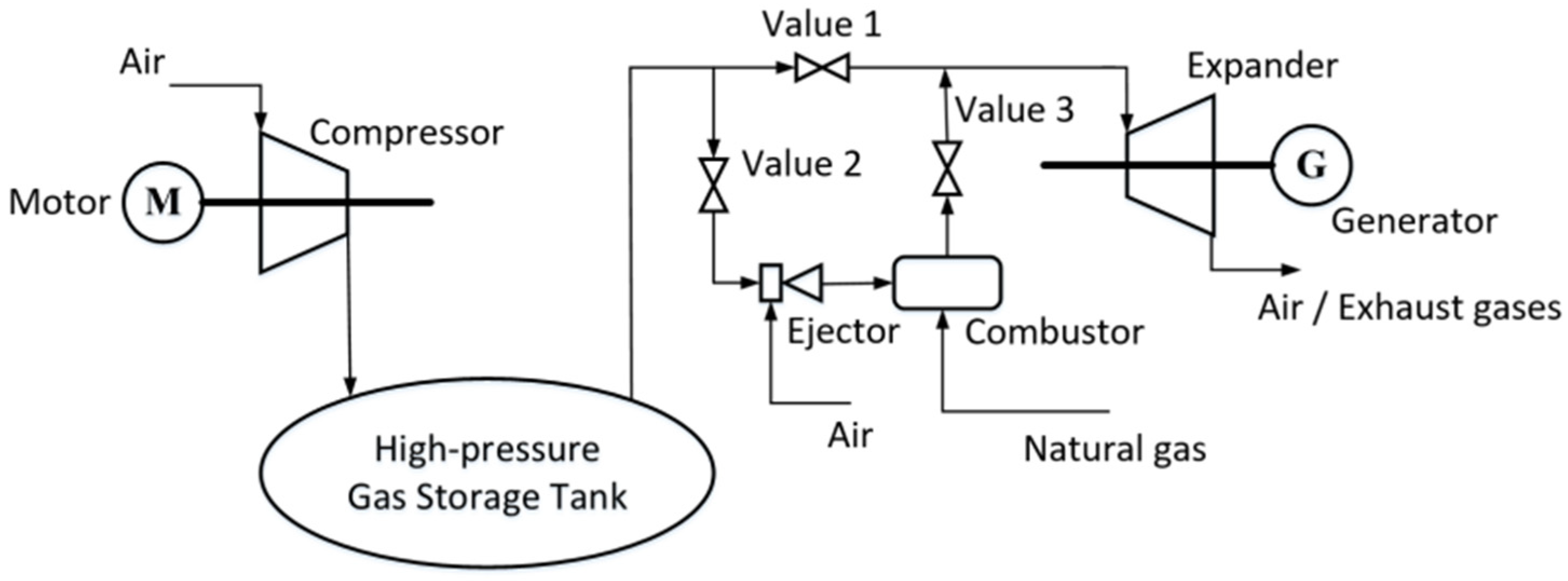
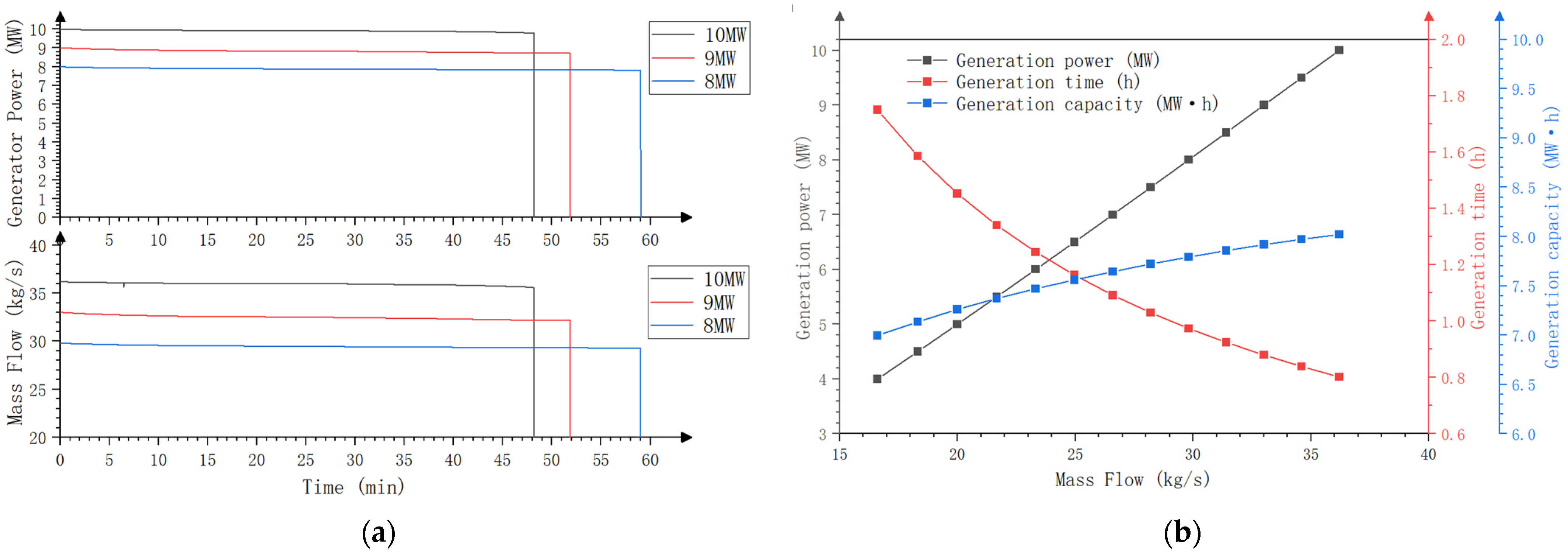

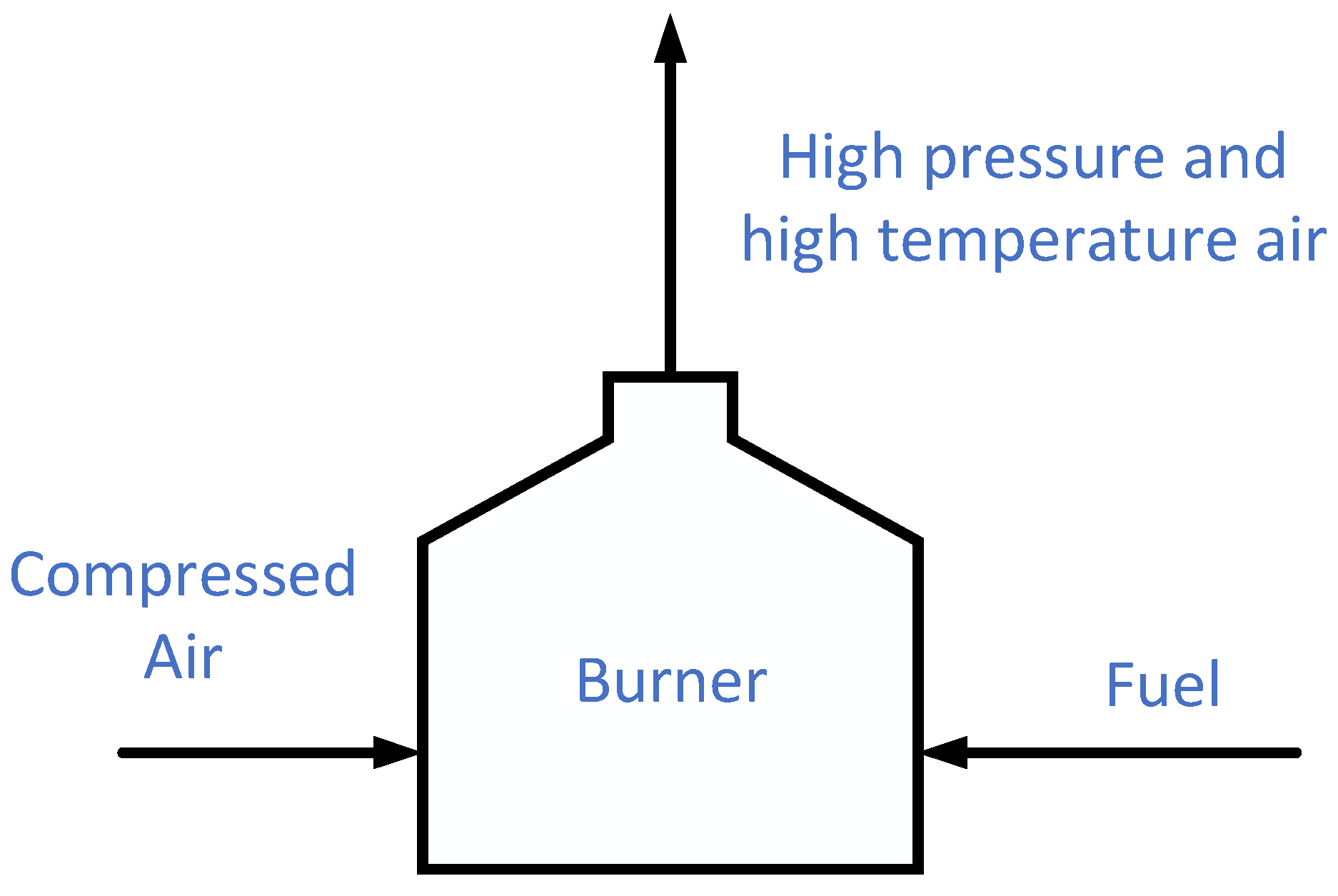
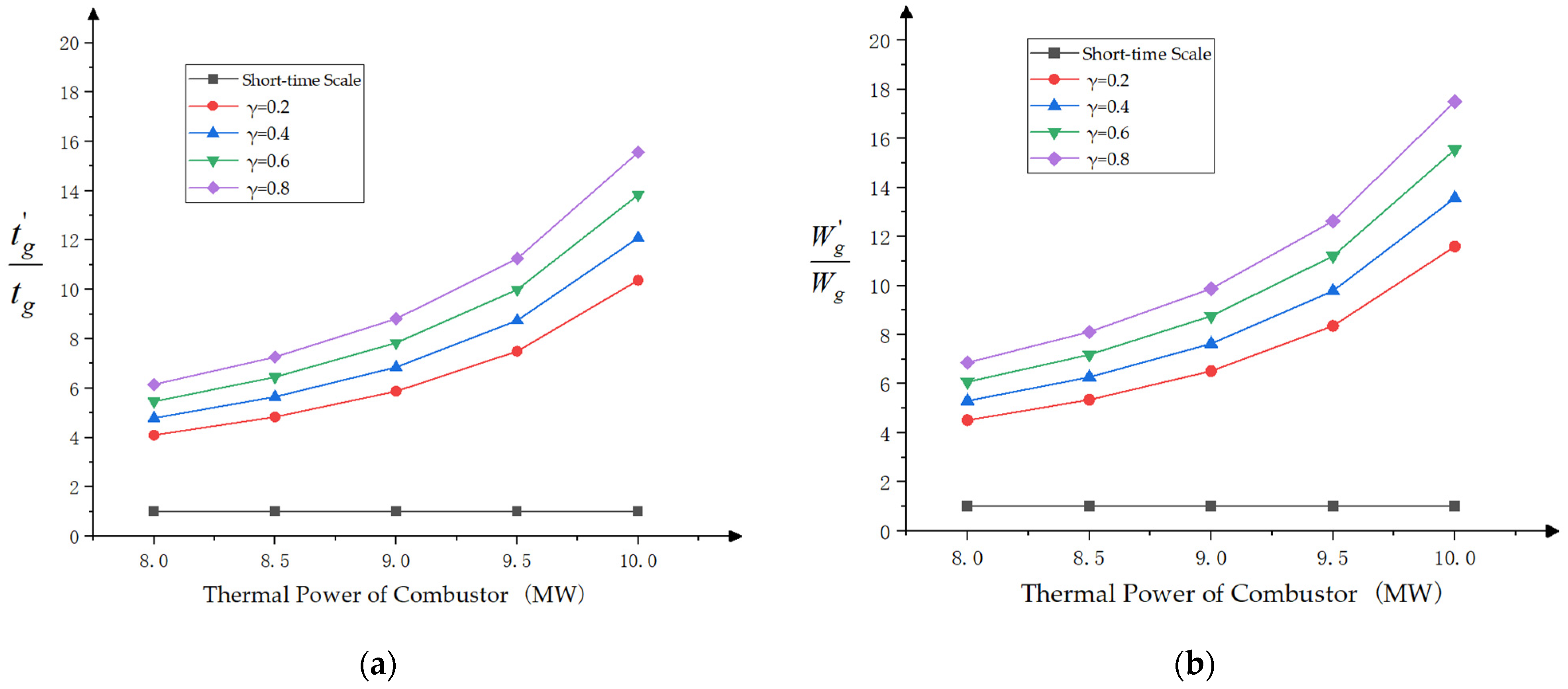
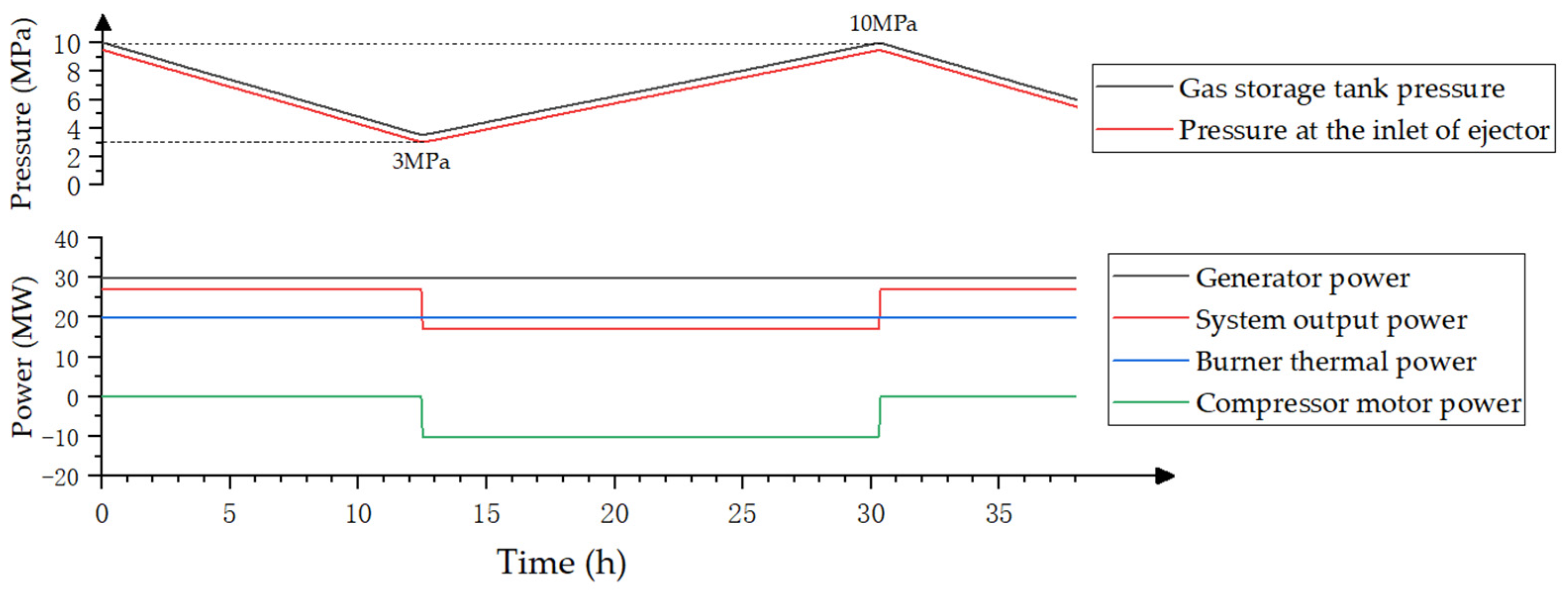
| Types | Typical Rated Power | Continuous Response Time |
|---|---|---|
| Electrochemical energy storage | 1 kW~50 MW | 1 min~4 h |
| Pumped storage | 100~2000 MW | 2~8 h |
| Compressed-air energy storage | 500 kW~300 MW | 1–26 h |
| Flywheel energy storage | 5 kW~5 MW | 15 s~15 min |
| Superconducting magnetic energy storage | 0.01~1 MW | ms~15 min |
| Supercapacitor | 0.01~1 MW | 1 s~15 min |
| Parameters | Units | Value |
|---|---|---|
| Energy-Release Power | MW | 10 |
| Energy-Release Pressure | MPa | 7 |
| Maximum Storage Pressure | MPa | 10 |
| Gas Storage Tank Volume | m3 | 6000 |
| Ambient Pressure | MPa | 0.1 |
| Ambient Temperature | K | 298 |
| 10 MW Release Time | s | 2880 |
| Hot Tank Temperature | K | 403 |
| Hot Tank Pressure | MPa | 0.4 |
| Cold Tank Temperature | K | 298 |
| Cold Tank Pressure | MPa | 0.1 |
| Compressor Motor Power | MW | 10 |
| Burner Thermal Power | MW | 20 |
| Burner Fuel | / | Natural Gas |
| Fuel Calorific Value | MJ/Nm3 | 36.22 |
| Electric Power Consumed by Other Auxiliary Machines of Energy Storage Subsystem | MW | 1.5 |
| Electric Power Consumed by Other Auxiliary Machines of Energy-Release Subsystem | MW | 1.5 |
| Generator Power | MW | 30 |
| Expander Stages | Unit | 1 | 2 | 3 | 4 |
|---|---|---|---|---|---|
| Inlet Pressure | MPa | 7 | 2.46 | 0.853 | 0.283 |
| Outlet Pressure | MPa | 2.48 | 0.873 | 0.303 | 0.1 |
| Inlet Temperature | °C | 82 | 82 | 82 | 82 |
| Outlet Temperature | °C | 14.4 | 7.6 | 10.0 | 18.0 |
| Pressure Loss in Heat Exchanger | MPa | 0.02 | 0.02 | 0.02 | 0.02 |
| Air Flow Rate | kg/s | 34.7 | 34.7 | 34.7 | 34.7 |
| Expansion Ratio | / | 2.82 | 2.82 | 2.82 | 2.82 |
| Isentropic Efficiency | / | 0.88 | 0.88 | 0.88 | 0.88 |
| Output power | MW | 2.536 | 2.786 | 2.691 | 2.358 |
| speed | r/min | 3 000 | 3 000 | 3 000 | 3 000 |
Disclaimer/Publisher’s Note: The statements, opinions and data contained in all publications are solely those of the individual author(s) and contributor(s) and not of MDPI and/or the editor(s). MDPI and/or the editor(s) disclaim responsibility for any injury to people or property resulting from any ideas, methods, instructions or products referred to in the content. |
© 2023 by the authors. Licensee MDPI, Basel, Switzerland. This article is an open access article distributed under the terms and conditions of the Creative Commons Attribution (CC BY) license (https://creativecommons.org/licenses/by/4.0/).
Share and Cite
Yang, D.; Wen, X.; Zhong, J.; Feng, T.; Deng, T.; Li, X. Compressed Air Energy Storage System with Burner and Ejector. Energies 2023, 16, 537. https://doi.org/10.3390/en16010537
Yang D, Wen X, Zhong J, Feng T, Deng T, Li X. Compressed Air Energy Storage System with Burner and Ejector. Energies. 2023; 16(1):537. https://doi.org/10.3390/en16010537
Chicago/Turabian StyleYang, Dahui, Xiankui Wen, Jingliang Zhong, Tingyong Feng, Tongtian Deng, and Xiang Li. 2023. "Compressed Air Energy Storage System with Burner and Ejector" Energies 16, no. 1: 537. https://doi.org/10.3390/en16010537
APA StyleYang, D., Wen, X., Zhong, J., Feng, T., Deng, T., & Li, X. (2023). Compressed Air Energy Storage System with Burner and Ejector. Energies, 16(1), 537. https://doi.org/10.3390/en16010537








